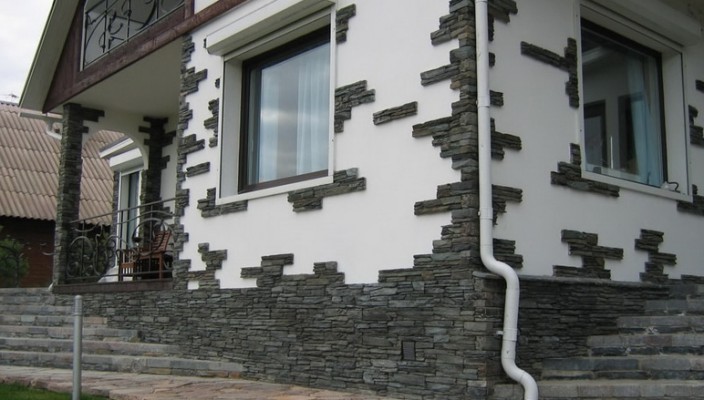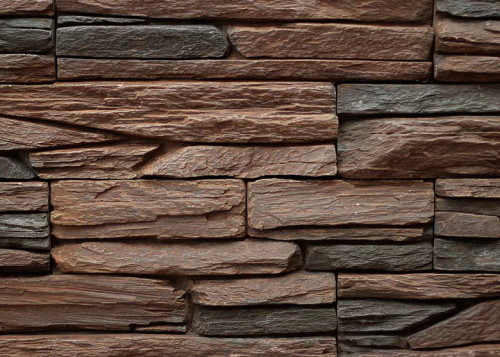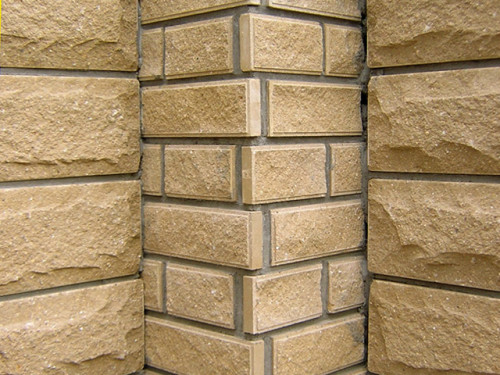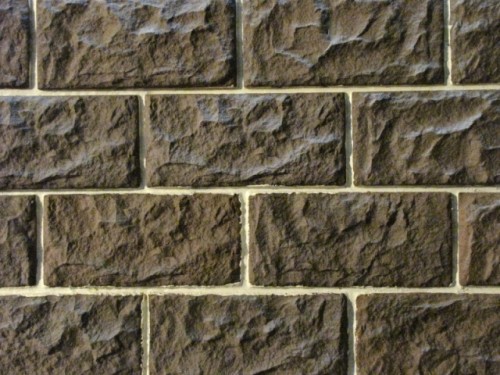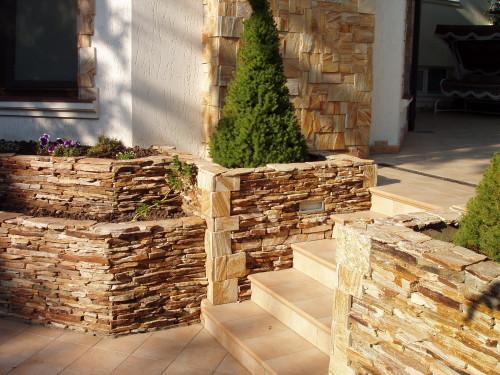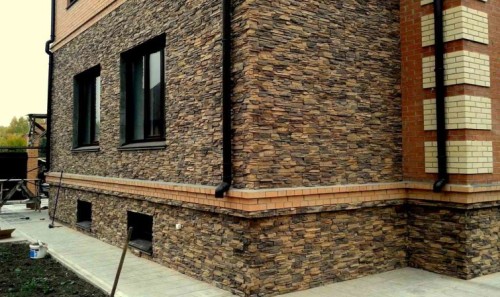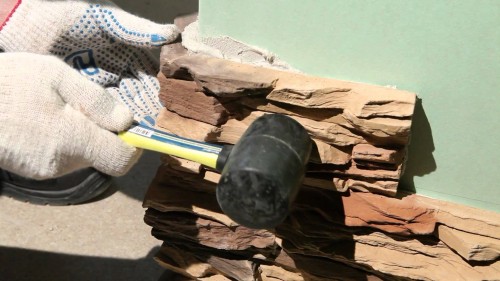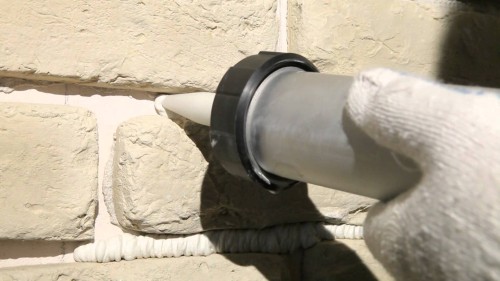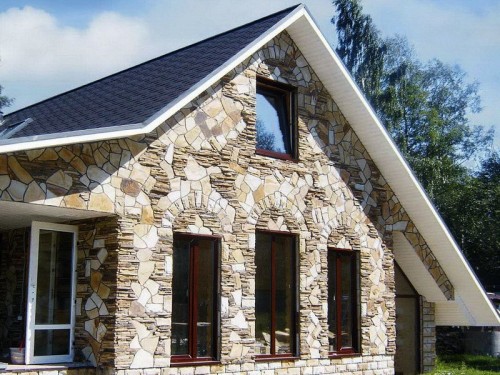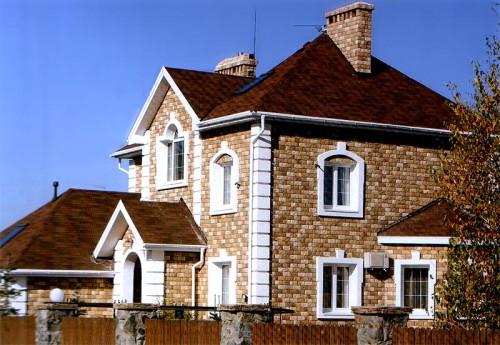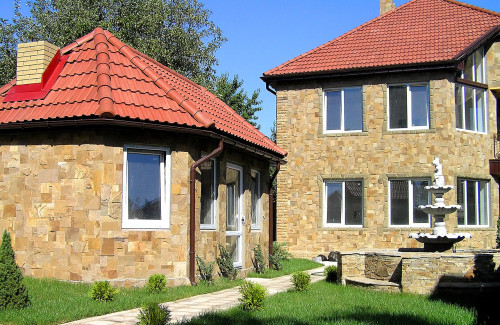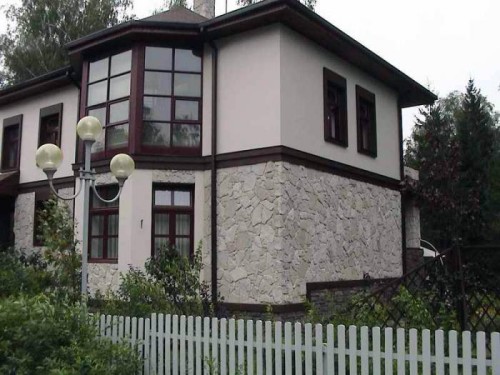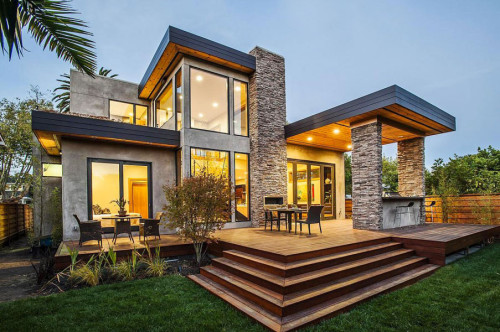To get a luxurious finish of the facade, it is not necessary to buy an expensive natural stone at all. Modern production technologies allow you to obtain artificial facing materials, according to the type not inferior to natural, but on operational qualities even superior to them. In this article we will tell about the finishing of buildings with decorative facade stone.
Content
Types, composition and characteristics of artificial stone
Artificial stone is produced by vibrating, mixing various components. As a rule, the composition of such material includes cement, sand, stone crumb, pigments and plasticizers, although, depending on the type of cladding, the components may differ.
Artificial stone is several varieties:
- Clinker - creates a simulation of natural chipped stone. In the process of manufacture, it gives the shape of clinker bricks or tiles. The clinker stone reproduces the sandstone surface. The basis of such a material is the refractory clay, which is subjected to strong heating. The facing of this species perfectly transfers heat and cold, temperature differences, high humidity. It is durable, firm and durable.
- Concrete stone is considered the most affordable in price, with which its popularity among consumers is connected. This type of material can copy almost any texture. Most often, a concrete stone is found to be found with the imitation of the corpus natural material or with the imitation of marble or granite. In the manufacture of a facade artificial stone that imitating the brushed, the concrete mixture is simply poured into the appropriate form and leave on the vibrotole. When the cement solution will freeze, the products are removed from the tanks. For material with imitation of granite and marble, a solution of high-strength decorative concrete is prepared, which, as in the above case, is poured into the forms and is pressed on the vibrationtole until it is frozen. A similar type of finish has good operational properties, according to the strength corresponding to the highest quality cement plaster.
- The architectural stone for the outer decoration is a kind of concrete material. It usually mimics the surface of natural limestone or sandstone. The basis for the production of such a material is portland cement, various mineral additives and modifiers that improve both decorative and operational properties of cladding.
- The polymerface stone is like a brickwork resembles a brickwork and is used most often for the purpose of finishing the foundation or basement. Materials made of polymers, thanks to which it acquires high ductility, flexibility, a small mass, good resistance to moisture, low and high temperatures. It is not as durable as its concrete counterparts, but thanks to the plasticity, it does not crack and is distinguished by a very long service life.
- The facade artificial stone based on the resin is very realistic imitates natural surfaces. On sale is presented by several forms: a ripple, rectangular, square. The main component in its composition is a natural stone in the form of crumbs, flour or other stone-made wastes. Raw materials are mixed with transparent synthetic resins that are characterized by high strength. The result of production is a durable, stable to many negative factors material with high decorative properties.
- Ceramic material for finishing facades also reproduces the stone surface, is made in the form of tiles or bricks. It can have both smooth and slightly embossed surface. This type of facing is not very popular, although it is used for the outer decoration of the buildings. The ceramic tile is durable, resistant to water and moisture, looks attractive, but poorly tolerates temperature differences. Since the expansion of the material itself and the adhesive layer under the action of temperatures is different, and the tile itself does not have the necessary elasticity, over time, cracks appear on it. Ceramic brick does not depend on the adhesive layer, and therefore is considered more durable.
Artificial facade stone, photo:
Advantages and disadvantages of artificial stone
- Unlike a natural analogue, artificial stone does not have a radioactive background, because it is much safer to use.
- For strength and duration of service, many types of artificial stone are not inferior to natural material, but they cost much cheaper.
- The mass of this facing is relatively small, which means to transport and mount the material much easier.
- Walls lined with decorative stone are reliably protected from moisture and water, various damage, cold and frost.
- It looks like a facade decor made of artificial stone beautifully and silent. The material imitates various surfaces: marble, granite, sandstone, wood and many others.
- Such cladding is environmentally friendly, does not contain harmful or toxic components, it does not burn.
- Caring for the surface is simple, since the stone is practically not dirty, and if it happens, it is very easy to wash it with simple water. In addition, the material can be processed by any detergent and cleaning agents.
- Stone does not fade in the sun, keeping the attractiveness during the entire service life.
- Since the material is light enough, it can be used in the decoration of frame or wooden houses without risk to create an excess load on the bearing walls. Mounting such a facing can be plasterboard or thermopanels.
The disadvantages of artificial stone are not so much. By cons, for example, you can attribute special conditions for working with the material. Facing the facade is allowed only at a certain temperature of air and working base, and this indicator must be within 5-25 ° C heat.
How to choose a stone for facing the facade
The laying of artificial stone will look at the most natural than the larger the number of forms of products are present in the manufacturer's set. The effect of naturalness can be achieved only if the same items will come across as less as possible.
Decorative effect also depends on the color of the material. It is desirable that several shades were present in the finish, and not one. Tile, painted in one color, looks monotonous and unnatural. So that the facade looked as natural as possible, try to combine about 2-3 shades of one color range in the trim.
Before buying an artificial stone, get acquainted with what moments it is worth paying attention to:
- The facial side of the products should not have traces of brushes, unnatural spots, unusual growths and other defects. If there are holes on the surface, their diameter should not exceed 2-3 mm.
- The reverse side of the items should be rough, so it is better to close with a working base. However, on its surface should not be separate protrusions exceeding 5 mm. The ideal option when the reverse surface of tiles or bricks has special grooves, whose height differences are 3-4 mm.
- It is desirable that the ends of the material were smooth and smooth, unless their curvature is provided for design. Smooth ends are easier to stick together, otherwise significant slots will remain between the elements. Small depressions with a diameter of up to 3 mm on the end parties may be present.
Laying artificial facade stone with their own hands
Preparatory stage
The entire process of mounting the facade stone can be divided into such basic stages as the choice of material, the preparation of the working base, laying of stone and stout seams. In the process of work, you will need certain tools and devices, which are shown below:
- construction level to check the smooth masonry;
- toothed spatula;
- pencil and square;
- bulgarian, so that it was what to cut the facade tile under the stone;
- electric drill with a special nozzle mixer for mixing the adhesive solution;
- metal brush;
- brush with soft bristles for cleaning the surface from dirt;
- painting brush;
- water container;
- capacity for the preparation of glue.
The facade stone can be mounted almost on any base, be it concrete, brick, wood, profile panels, foam blocks or something else. Before putting an artificial facade stone on foam concrete or some other surface, it needs to be prepared. Even if the wall remains slightly rough, there should be no significant differences of heights. Otherwise, you will get an ugly, inesttic result, and crooked tile, besides, also quickly disappear.
Align the base to the perfect state makes sense if you mount smooth elements, for example, imitating brick or river stone. For laying parts with a embossed surface, a wall can be left rough.
Before assessing an artificial facing facade stone, take the construction level and check the smoothness of the working base. If the height differences do not exceed 3-5 mm, the stone can be laid without prior alignment of the surface. If the differences are more significant, then on concrete, plastered or brick bases, the alignment is carried out with fresh plaster or putty. The plastered surfaces are previously checked with climbing strength. Displaced places are knocked down, cleaned, shuffled with fresh mortar. The solution is also applied to gaps and gaps, and all the protrusions, on the contrary, are considered.
Wooden walls prepare for work somewhat differently. They remove nails, swirls and other discover elements. Then the wood is checked for mold, rot, dark spots, traces of koroedov, etc. What is damaged by fungi or pests is dismantled and replaced with new details. Then the boards are treated with antiseptics. All items that are poorly held and rolled are additionally fixed. After drying, the antiseptic tree is hydroxulated. If the wooden wall is smooth, it is covered with the reinforcing mesh, on top of which they produce stone mounting. If the surface is uneven, it is recommended to be pre-plasted.
The most common and optimal way of laying an artificial stone on wooden walls is the creation of a ventilated facade. Under such cladding the walls do not succeed and do not rot, they have access to fresh air, which allows to preserve the operational properties of the material for many years. The device of the ventilated facade can be briefly described in the form of such steps:
- Initially, on the wall make a crate. If wooden elements are used to create it, they are impregnated with appropriate compositions and covered with waterproofing.
- In the free space of the design, you can pave the insulation to reduce the heat loss of the walls and save on heating.
- Asbestos or chip-cement plates are mounted on the crate. Such plates will create a smooth surface suitable for styling stone.
- Then the selected material is then laid on the prepared walls.
Verification of working materials
All items before laying should be checked. Deficious stones set aside, so as not to interfere with work. If you have acquired several parties of the goods, then you will consider that they can vary slightly. To subsequently lay them evenly, mix products from all parties among themselves. So the tint of the masonry will turn out to be more natural, and there will be no risk that extensive dark and bright areas are formed on the wall.
To decide on the session of the installation of parts, spread them on the floor in the appropriate order. You can trim in advance the excess protruding parts of the stones with the help of a grinder with a special disk. The side that you will be covered with glue, clean the metal brush thoroughly.
Now let's talk about what glue should be used in work:
- The glue for the stone should be in its composition cement, sand, mineral components and organic solvents, as well as plasticizers.
- Pay attention to the temperature range in which a specific composition can be used. Adhesive for external work should have good moisture resistance, temperature fluctuations.
- It should not be glanced than after 1 hour. At the same time, you can correct laying shortcomings for 30 minutes.
- It is best to acquire dry mixes to subsequently prepare a solution of them immediately before work and small portions.
- If you make the adhesive solution yourself, then make sure that the consistency allows you to apply it with a thin layer. The mass must also be elastic, do not contain lumps. Stone elements must be firmly held on the wall, do not slide on the glue.
Artificial Facade Stone Installation Technology
- Before laying a facing material, the wall need to be covered with a primer or simply moisten with water. It is convenient to do this with a wide soft brush or roller. The primer is applied to the wall for about 20-30 minutes before the start of installation.
- The laying of details can be started both from above and below. It is believed that moving-up is more convenient to move, in such a way it is also more convenient to adjust the mechanism of installation. But if you start working from the upper row, the stones below will not be turned off with the adhesive glue.
- The angular elements are mounted the first. Then stacked the stones around the door and window openings. Rows must be strictly horizontal if smooth stones are used in the work.
- When the corners and openings are processed, you can start filling the rest of the space with finishing material. The adhesive solution should be applied both on the wall and on the product. The solution layer should be approximately 5-10 mm. The front side of the stones is preferably maintained in its pure form.
- So that the detail attached more closely to the base, press it as much as possible and slightly slide from the side to the side. From under the tiles there should be a small amount of glue.
Stone laying can be suture or seamless. With the first way, the installation between the elements should be left a small space. After soaring glue, the seams are smeared with a special solution and in the fresh mixture make the extender using or a cord of a circular cross section, or a tool intended for such purpose. Apply a solution in the seams is convenient with the help of a device, which can be made with your own hands. For this, a dense polyethylene package is taken, it is filled with the prepared mass, the tip of the package is cut and through the resulting small hole, the solution is applied to the gaps between the stones. If part of the mass got on the front of the material, it must be immediately witch.
If the masonry is seamless, the glue protruding in the gaps is carefully cleaned with a spatula. The stone masonry is customary to finish approximately 6-7 cm from the ground, so that during the cold it does not come into contact with the simplifying soil and did not appear.

